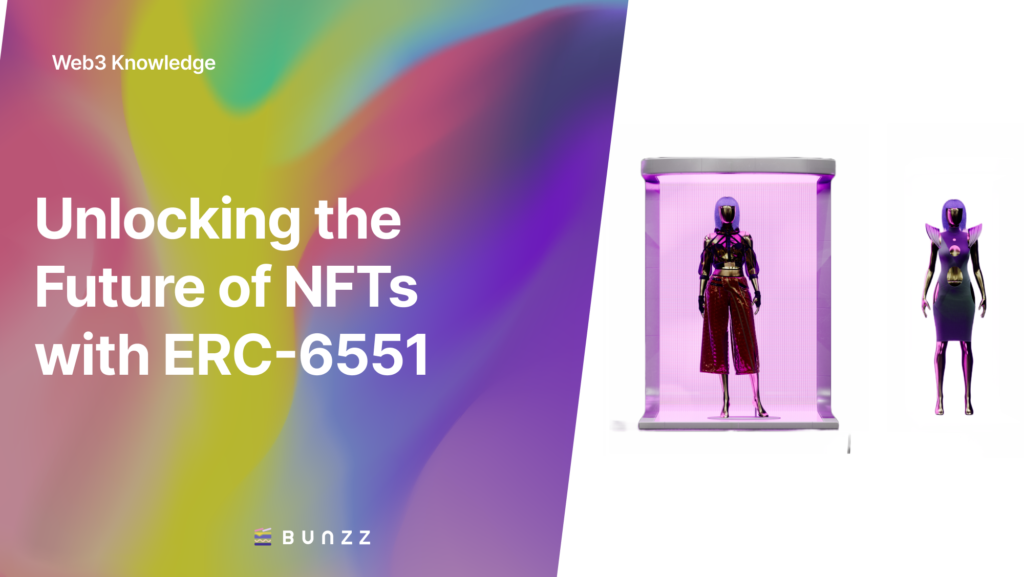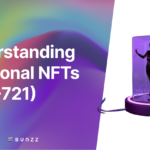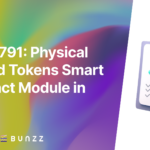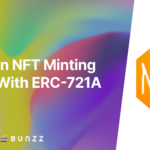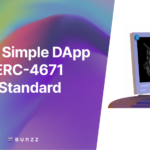Introduction:
The world of non-fungible tokens (NFTs) has witnessed tremendous growth and innovation, transforming the digital ownership landscape. NFTs provide a unique way to represent and trade digital assets securely on the Ethereum blockchain.
The management of assets associated with NFTs has posed limitations within traditional NFT standards. In response, the Ethereum blockchain ecosystem has introduced a new standard known as ERC-6551 as an Ethereum eip standard improvement proposal. This proposal introduces on-chain wallets that are specifically designed for NFTs, aiming to solve the challenges associated with managing assets in the NFT space.
In this article, we will explore the concept of ERC6551 and delve into its technical aspects and implications.
What is ERC6551?
ERC-6551 is the Ethereum standard for token-bound accounts. It assigns a smart contract wallet to each NFT, improving its interoperability, dynamism, and interactivity.
ERC6551 is an extension of the existing ERC721 and ERC1155 standards, specifically designed to enhance NFT functionality by introducing on-chain wallets. With ERC6551, each NFT is associated with its own on-chain wallet, enabling seamless management and interaction with the assets owned by the NFT. This standard allows NFT holders to have full control over their assets, facilitating better asset monetization, trading, and utilization within the Ethereum ecosystem.

Benefits of ERC6551:
- Improved Asset Management: Traditional NFT standards treat assets as separate entities from the NFT itself. ERC6551 solves this problem by providing a dedicated on-chain wallet for each NFT, allowing for seamless asset management and ownership.
- Simplified Asset Transactions: With ERC6551, assets associated with an NFT can be traded as a bundle, eliminating the complexities of individually transferring each asset. This simplifies the process of selling or transferring complete collections while maintaining asset integrity.
- Enhanced Interoperability: By associating each NFT with an on-chain wallet, ERC6551 enables NFTs to participate equally within the Ethereum ecosystem. Wallets are universally supported, allowing digital arts as NFTs to leverage existing tools and services designed for wallets.
- Expanded Use Cases: The introduction of on-chain wallets for NFTs opens up new possibilities for on-chain gaming and inventory management. NFTs can now represent characters with associated assets, enabling seamless trading, upgrading, or customization of in-game items.
- Immutable Activity Record: Ensuring Transparent Ownership and Transaction History Token bound accounts established by ERC-6551 maintain an immutable record or permissionless registry of all on-chain activities performed by the accounts. This unalterable activity record provides a comprehensive provenance of ownership, transactions, and utility for NFTs. By ensuring transparency and accountability, ERC-6551 instills trust and confidence in the NFT ecosystem.
Developer Use Cases
A. Enhanced NFT Functionality
Token bound accounts enable NFTs to become more than just static assets. They allow for the bundling of related assets, automatic staking, collecting rewards, and seamless asset transfers between platforms. This unlocks a new level of functionality and utility for NFT holders.
B. Empowering On-Chain Identities
With token bound accounts, NFTs can now own wallets and associated assets. This paves the way for the creation of full on-chain identities and reputations as NFTs. Developers can build reputation systems based on an NFT’s on-chain activities, enabling users to establish trustworthiness or track a history of successful transactions. This can be particularly useful in decentralized marketplaces, lending platforms, or gaming ecosystems where reputation and trust play crucial roles.
Behavioral economics-driven airdrops, loyalty programs, and efficient lending protocols are among the many possibilities that arise from this innovation.
C. Revolutionizing Gaming Experiences
Token bound accounts offer game developers the ability to consolidate all in-game assets within a character’s wallet. This simplifies asset management, improves user experiences, and opens the door to creating complex in-game UIs that were previously challenging to implement.
Play-to-Earn Mechanics: ERC-6551 enables the integration of play-to-earn mechanics, revolutionizing the relationship between gamers and the value they derive from their gameplay.
By utilizing TBAs, developers can design games where in-game achievements, assets, and progress directly translate into tangible value stored within the player’s TBA. This value can be in the form of tokens, NFTs, or other tradable assets, allowing players to monetize their gaming skills and time invested. Cross-Game Interoperability ofERC-6551 enables seamless interoperability between different games and gaming platforms. Developers can design games that allow players to transfer assets, items, or progress between different TBAs, even across disparate gaming ecosystems.
D. Provenance and Transparency:
Developers can utilize ERC-6551 to enhance provenance and transparency within their applications. By utilizing TBAs, developers can maintain an immutable record of all on-chain activities associated with an NFT. This enables users to have a comprehensive view of an NFT’s transaction history, utility, and interactions, fostering trust and transparency within the ecosystem.
How it Works: Architectural Aspects of ERC-6551
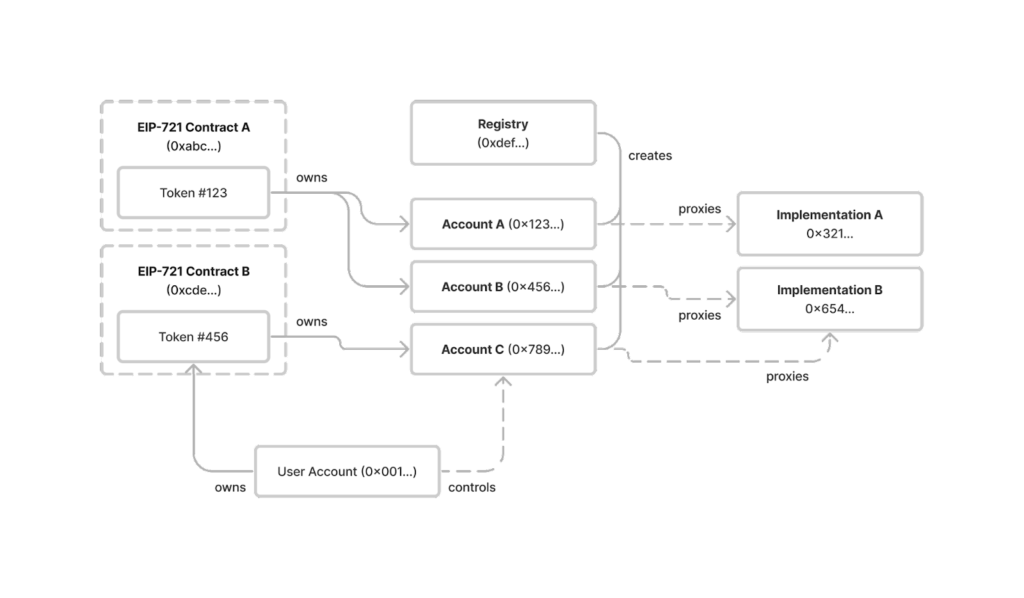
Registry
The registry serves as a single entry point for projects wishing to utilize token bound accounts. It has two functions:
- createAccount – deploys a token bound account for an ERC-721 token given an implementation address
- account – a read-only function that computes the token bound account address for an ERC-721 token given an implementation address
The registry SHALL deploy each token bound account as an ERC-1167 minimal proxy with immutable constant data appended to the bytecode.
Account creation:
Users create their token-bound accounts in ERC-6551 by linking them to specific cryptographic tokens of their preference. This connection establishes a trustless relationship between the account and the chosen token.
Access and authorization:
Exclusive access to the ERC-6551 token-bound account is granted solely to individuals who possess the corresponding cryptographic token. This ensures that only authorized users can interact with the account, enhancing security and reducing potential risks.
Transaction execution
Users now have the ability to perform various actions within their token-bound accounts, such as transfers, exchanges, and executing smart contracts. These transactions undergo validation and execution on the underlying blockchain network, preserving the decentralized nature of the ecosystem.
Examples of Projects that are embracing ERC 6551
Here are some real-world examples of projects that have implemented ERC-6551 and are actively utilizing its features:
- STAPLEVERSE is a pioneering project that has embraced ERC-6551. They have integrated token-bound accounts into their ecosystem, allowing users to store assets and perform transactions within their NFTs. In SAPIENZ, users receive a customizable character that they can outfit with cosmetics
- POAP EX is a Dapp project utilizing ERC-6551 to enhance the POAP ecosystem by providing a missing component and perfecting the POAP economic system. By deploying the ERC6551Registry contract and ExampleERC6551Account contract, POAP EX enables the creation of token-bound accounts for users within the ecosystem. This integration allows for the seamless management and interaction of assets within POAP NFTs, providing a more comprehensive and enhanced user experience.
Other Ecosystem that could adopt the ERC 6551 Standard
- Gaming Platforms: Several gaming platforms have adopted ERC-6551 to enhance the gaming experience. By utilizing token-bound accounts, players can consolidate their game-related assets within their NFTs, simplifying asset management and improving user interaction.
- DeFi Protocols: Some decentralized finance (DeFi) protocols have integrated ERC-6551 to enable users to store and interact with assets directly within their NFTs. This integration expands the capabilities of NFTs, enabling them to participate in DeFi activities such as lending, borrowing, and yield farming.
- Identity and Reputation Systems: Projects focused on building identity and reputation systems on the blockchain have implemented ERC-6551. This integration allows NFTs to have their own identities and reputations, facilitating behavioral economics-driven airdrops, loyalty programs, and other personalized interactions.
The Impact on the Web3 Industry
The introduction of Ethereum Improvement Proposal (EIP) ERC-6551 opens up exciting avenues for the use of NFTs (non-fungible tokens). This proposal significantly enhances the potential applications, games, and experiences that can be developed using digital items. By enabling greater interactivity, composability, and on-chain functionality for digital assets, ERC-6551 paves the way for a new wave of NFT-driven projects.
One of the key benefits of this proposal is the improvement in user experiences. With token-bound accounts, asset management and transfers become much simpler, resulting in a seamless and intuitive user experience. This enhancement is particularly valuable for newcomers to the blockchain, as it eliminates the need to create separate wallets or manage complex seed phrases. The integration of popular browser extensions like MetaMask simplifies the process even further, allowing users to easily install MetaMask and manage their NFTs directly from their browsers.
Digital art, an increasingly popular use case for NFTs, stands to benefit greatly from ERC-6551. Artists can now create more interactive and dynamic digital artworks that can be experienced directly through the browser, thanks to the enhanced on-chain functionality. Buyers can browse and purchase NFTs through browser extensions, expanding the accessibility and reach of digital art.
Moreover, ERC-6551 addresses the issue of transfer limits associated with some NFT platforms. With the improved on-chain functionality, the proposal allows for smoother and faster transfers of digital assets, eliminating unnecessary restrictions. Users can now freely buy and sell NFTs without cumbersome limitations, fostering a more vibrant and dynamic NFT marketplace.
The integration of browser extensions, such as the MetaMask extension, further amplifies the potential of ERC-6551. Users can seamlessly install MetaMask and manage their NFTs, making the entire process more user-friendly and accessible. This integration also facilitates social recovery, allowing users to restore access to their digital assets through a social network or trusted contacts in case of loss or compromised accounts.
The introduction of ERC-6551 and the integration of browser extensions have significant implications for the NFT ecosystem. By fostering innovation and attracting talented developers and entrepreneurs, these advancements encourage the exploration of new possibilities within various industries beyond art and collectibles. The improved user experiences, streamlined asset management, and expanded functionalities are poised to drive the adoption of blockchain technology on a broader scale.
Conclusion
ERC-6551, the groundbreaking standard for NFTs, has paved the way for a transformative shift in the NFT landscape. By introducing Token Bound Accounts (TBAs), NFTs now possess their own wallet addresses, revolutionizing the way assets are stored, managed, and interacted with.
The advantages of TBAs over traditional wallet storage methods are evident, offering composability, on-chain identities, provenance, and extended dependencies. This standard has already found implementation in projects like StapleVerse and POAP EX, where token-bound accounts are utilized to perfect the POAP economic system and improve game character design.
As the adoption of ERC-6551 grows, we can anticipate a future where NFTs evolve from static representations to dynamic and valuable digital assets. Embrace the power of ERC-6551 and witness the transformation of the NFT ecosystem. The revolution has just begun!
